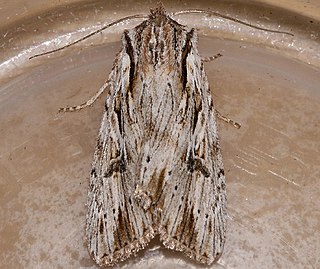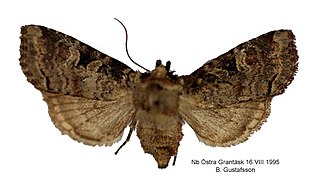Parabagrotis cupidissima is a species of moth in the family Noctuidae. It was described by Augustus Radcliffe Grote in 1875 and is found in North America, where it ranges from southern Vancouver Island, along the Pacific Coast states, to southern California. The habitat consists of grasslands and oak woodlands.
Parabagrotis insularis is a species of moth in the family Noctuidae. It is found in North America, where it has been recorded from southern Vancouver Island, along the Pacific Coast through California to near the border with Mexico. The species was described by Augustus Radcliffe Grote in 1876.
Xestia verniloides is a species of cutworm or dart moth in the family Noctuidae. It was described by J. Donald Lafontaine in 1998 and is found in North America.
Spragueia jaguaralis is a species of bird dropping moth in the family Noctuidae. It was described by George Hampson in 1910 and is found in North America.

Papaipema speciosissima, the osmunda borer or regal fern borer, is a species of cutworm or dart moth in the family Noctuidae. It was described by Augustus Radcliffe Grote and Coleman Townsend Robinson in 1868 and is found in North America.

Xestia infimatis is a species of cutworm or dart moth in the family Noctuidae. It was described by Augustus Radcliffe Grote in 1880 and is found in North America.
Euamiana endopolia is a moth in the family Noctuidae. It was described by Harrison Gray Dyar Jr. in 1912 and is found in North America.

Hillia iris, the iris rover, is a species of cutworm or dart moth in the family Noctuidae. It was described by Johan Wilhelm Zetterstedt in 1839 and is found in North America.
Hypena ramstadtii, or Ramstadt's hypena, is a species of moth in the family Erebidae. It was described by Alex K. Wyatt in 1967 and is found in North America.
Perigonica pectinata is a species of cutworm or dart moth in the family Noctuidae. It was described by Smith in 1943 and is found in North America.
Coxina cinctipalpis, the black-waved owlet, is a species of moth in the family Erebidae. It was described by Smith in 1899 and is found in North America.
Chaetaglaea fergusoni, or Ferguson's sallow moth, is a moth in the family Noctuidae. It was described by Vernon Antoine Brou Jr. in 1997 and is found in North America.
Bagisara pacifica is a moth in the family Noctuidae. It was described by William Schaus in 1911 and is found in North America.

Sympistis infixa, the broad-lined sallow moth, is a moth in the family Noctuidae. It was described by Francis Walker in 1856 and is found in North America.
Homorthodes dubia is a species of cutworm or dart moth in the family Noctuidae. It was described by William Barnes and James Halliday McDunnough in 1912 and is found in North America.
Dichagyris neoclivis is a species of cutworm or dart moth in the family Noctuidae. It was described by William Barnes and Foster Hendrickson Benjamin in 1924 and is found in North America.
Tesagrotis corrodera is a species of cutworm or dart moth in the family Noctuidae. It was described by Smith in 1907 and is found in North America.
Papaipema pterisii, the bracken borer moth, is a species of cutworm or dart moth in the family Noctuidae. It is found in North America.

Phosphila miselioides, the spotted phosphila, is a species of cutworm or dart moth in the family Noctuidae. It was described by Achille Guenée in 1852 and is found in North America.
Xestia lupa is a species of cutworm or dart moth in the family Noctuidae. It is found in North America.




